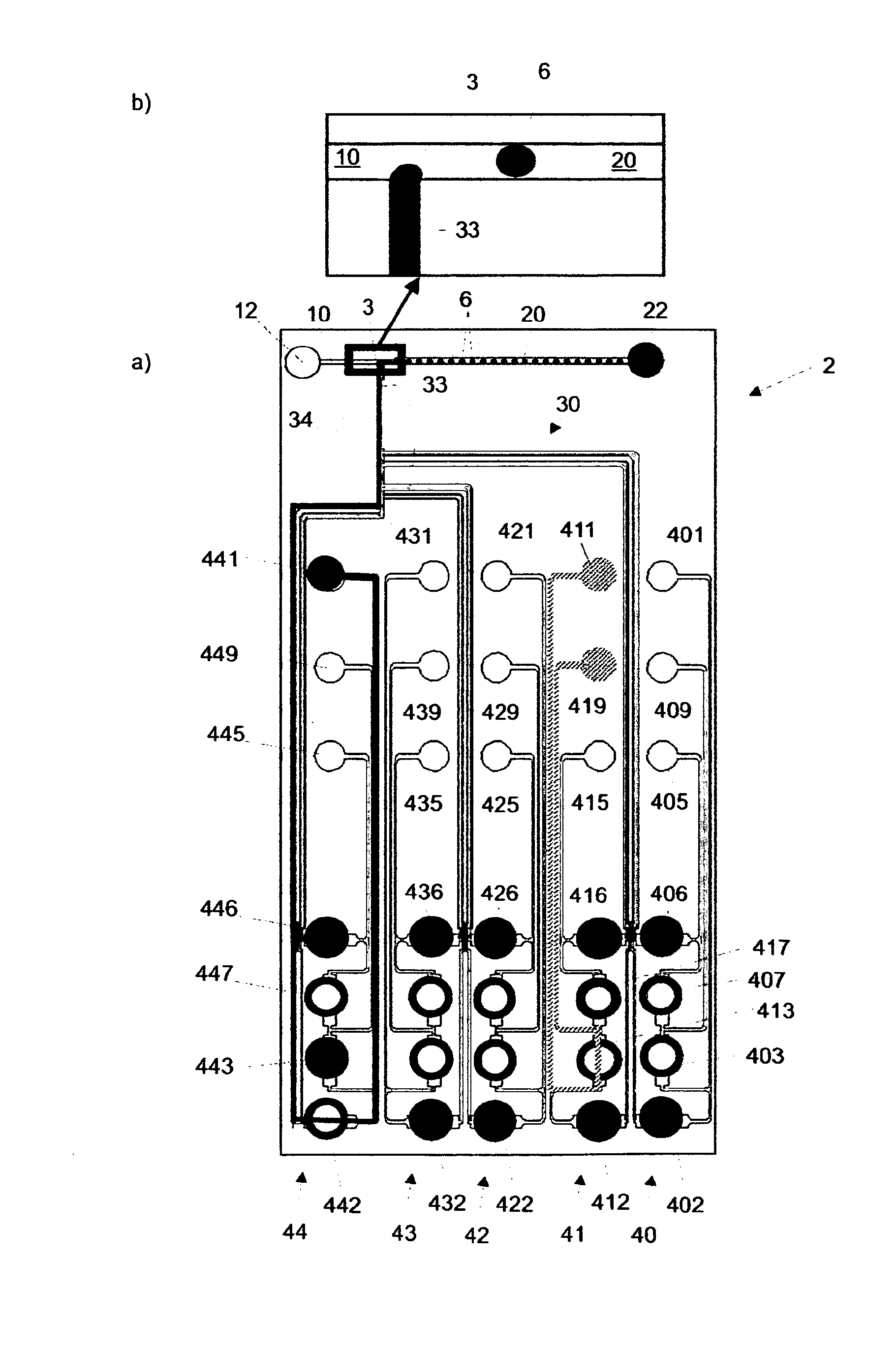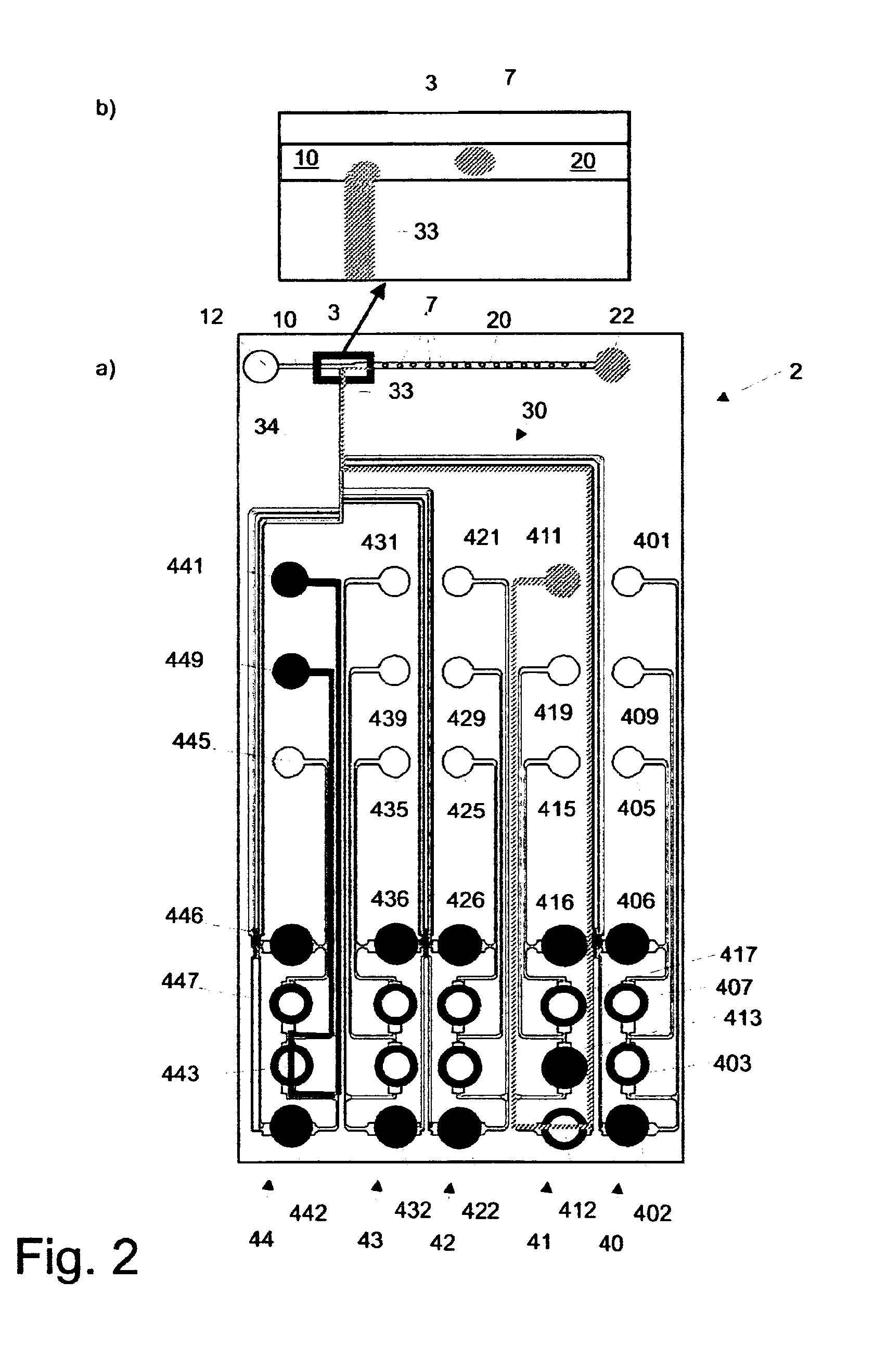Microfluidic Device
a microfluidic device and microfluidic technology, applied in the direction of diaphragm valves, laboratory glasswares, optical radiation measurement, etc., can solve the problems of difficult to achieve a good level of control, difficult to systematically generate all possible droplet pairs, and strict limitations of the maximum flow rate and hence throughput of the negative pressure driven system. , to achieve the effect of short switching times
- Summary
- Abstract
- Description
- Claims
- Application Information
AI Technical Summary
Benefits of technology
Problems solved by technology
Method used
Image
Examples
example 1
Stem Cell Differentiation
[0058]The microfluidic apparatus 2 is used to screen media ingredients (e.g. growth factors and chemical stimuli) triggering the differentiation of stem cells into specific lineages (e.g. neurons, muscle cells, etc.). It is well known that the differentiation of stem cells is dependent on many (chemical) factors in parallel. Hence screening combinatorial mixtures of media ingredients is required and even commercially exploited in conventional systems (e.g. plasticell). While a conventional setup requires large amounts of stem cells and only allows for relatively low throughput, the microfluidic apparatus 2 of the present disclosure can circ vent these limitations.
[0059]In this example, a suspension of stem cells as well as a number of growth factors and chemical stimuli are continuously injected into (different inlets of) the microfluidic apparatus 2. Using a predefined sequence of valve configurations, all possible combinations of growth factors and chemica...
example 2
[0064]The novel microfluidic apparatus 2 is used to set up samples containing different reactants for the combinatorial synthesis of bioactive molecules. For example, the microfluidic apparatus 2 can be used to mix azides and alkenes for “click chemistry” reactions (e.g. Huisgen 1,3-Dipolar Cycloaddition) in a combinatorial fashion. In this approach, a number of alkenes (n) and a number of azides (z) are continuously injected into the microfluidic apparatus 2. Using a predefined sequence of valve configurations, all possible alkeneazide pairs are co-encapsulated into the product droplets 6. Downstream of the encapsulation step, the product droplets 6 are incubated at elevated temperature for a time period sufficient to obtain the products of the chemical reactions.
[0065]Subsequently, the product droplets 6 are mixed with assay reagents to test for biological activity of the newly generated products. For this purpose, the product droplets 6 are fused with dropl...
example 3
Screening Potent Drug Combinations
[0067]Many diseases cannot be cured based on the application of a single drug acting on a single drug target. For example, HIV infections are usually treated using highly active antiretroviral therapy (HAART). In this approach, drug cocktails targeting different viral proteins (e.g. Reverse Transcriptase, HIV protease or the Envelope protein) are administered at the same time to avoid the generation of resistant mutants. Similarly, the treatment of cancer or multi-resistant bacteria often involves the application of drug cocktails.
[0068]The microfluidic apparatus 2 of the present disclosure can be used to systematically encapsulate all possible combinations of a given number of drugs into droplets and monitor their potentially cumulative effects on a co-encapsulated pathogen (also infused through one of the inlets of the device). After the sample generation and an incubation time allowing the pathogen to proliferate, the product droplets 7 and their...
PUM
| Property | Measurement | Unit |
|---|---|---|
| polydispersity | aaaaa | aaaaa |
| height | aaaaa | aaaaa |
| width | aaaaa | aaaaa |
Abstract
Description
Claims
Application Information
 Login to View More
Login to View More - R&D
- Intellectual Property
- Life Sciences
- Materials
- Tech Scout
- Unparalleled Data Quality
- Higher Quality Content
- 60% Fewer Hallucinations
Browse by: Latest US Patents, China's latest patents, Technical Efficacy Thesaurus, Application Domain, Technology Topic, Popular Technical Reports.
© 2025 PatSnap. All rights reserved.Legal|Privacy policy|Modern Slavery Act Transparency Statement|Sitemap|About US| Contact US: help@patsnap.com



